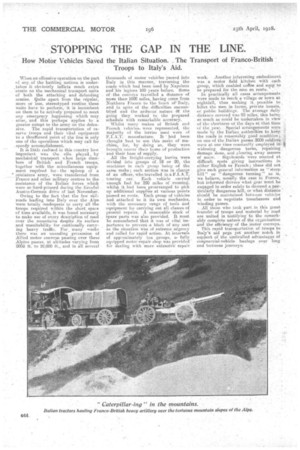STOPPING THE GAP IN THE LINE.
Page 20

If you've noticed an error in this article please click here to report it so we can fix it.
How Motor Vehicles Saved the Italian Situation. . The Transport of Franco-British Troops to Italy's Aid.
When an offensive operation on the part of anv. of the battling nations is undertaken it obviously inflicts much extra -etiesin on the mechanical transport units of both the attacking and defending armies. Quite apart from the r4gu1ar, more or less, stereotyped routine these units have to .perform, • it is incumbent on them to be actively prepared to meet any emergency happening .which may arise, and this perhaps applies to a greater extent to the army on the defen sive. The rapid transportation of reserve troops and their vital equipment to a threltened point of the lino is only one of the operations which may call for speedy accomplishment. It is little realized in this country how. impotent was the role played., by mechanical 'transport. when large slumbers of British • and French troops, together with the miscellaneous equipment required for-the upkeep of a miniature army, were transferred from France and other military centres to the assistance of the Italian forces which were ee Itard-pressed during.the feweefnl Austro-German drive of last November.
Owing to the fact that the few railroads leading into Italy over the Alps were totally inadequate to carry all the troop.% required within the short. space of time available, it was found neeessary to make use of every description of road over the mountains despite its surface and unsuitability for continually carrying heavy traffic. For many weeks there was an unending procession of Allied motor conwnes passing over these Alpine passes, at altitudes varying from 8000 ft. to 10,000 ft., and in all several
thousands of Motor vehicles passed into Italy in this manner,traversing the roads which had been used by Napoleon and his legions 100 yearsbefore, Some of. -the convoys travelled a distance of more than1000 miles, having come from Northern France to the heart of Italy, and in spite of the difficulties encouritdred and the ardueue nature IN the going they worked to the prepared' schedule with rerinirkable accuracy.
Whilstmany makes of British and French vehicles. were represented; the majority of the lorries used were of F.I Al. . manufacture. It ' had been thought best to use this make of machine, for, by doing so, they were beought dearer their home of production and their base of supply. I All the freight-carrying lorries were divided into groups of. 18 or 20, the machines in each group 'being of the same make; each section Was in cbarge of an officer, Who travelled in a
touring car. Each vehicle carried enough fuel for 250 miles of ramming, whilst it had been prearranged to pick upadditional supplies) at various points passed en route. Each group of vehicles had attached to it its own mechanics. with the necessary range of tools and 'equipment for carrying out all classes of general repairs. A reasonable Stock of 'Spare' parts was also provided. It must be remembered that it was of vital importance to prevent,a hitch of any sort as the situation was of extreme urgency and called for rapid action. At intervals of approximately ten groups, a• fully equipped motor-repair shop was provided for dealing with more extensive repair. work. Another interesting embodiment • was a motor field kitchen with each group, -which enabled coffee and soup. to be prepared for the Men en route. . In practically all ea.tiee .arrangements: were made to reach a village or town at tmightfall, thus making it possible to
billet the men in farms private houses,or public buildings. Tlie average daily
distance coyered was 00 miles, this being, as much as could he Undertaken in _vieviof the shortness of the days at that time ,. of the year. Special arrangements were made by the Italian authorities to keep' the roads in reaeonahiy geed denttiljon on one of the Italian paaves 2000 soldiert were at one time constantly employed in.,: widening dangerous turns, repairing damage done, and -.clearing away masses of snow. Signboards were erectedat difficult spots giving instructions in either English or French; these did not • give -such general information as "steep hill" or dangerous turning " as is, we believe, usually the case in France, • but informed drivers what gear must be eiigaged in order safely to descend a.particularly dangerous hill, or what distairee should be maintained between vehictes in order to negotiate treacherous and winding passes. _ All those who took part in this great transfer of troops and material by road are united in teStifying to the remarkably complete nature of the organization aim. the efficiency-of the motor convoys. _ This rapid transportation cif troops to aid pegs yet another notch in support of the unrivalled advantages of commercial-vehicle haulage over long ans.14 tortuous journeys






















